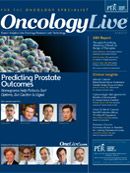Nilotinib Responses Better Than Imatinib in CML Trials
Two phase III clinical trials showed that nilotinib continues to demonstrate more favorable molecular response levels in patients with Ph CML than imatinib mesylate.
Two phase III clinical trials showed that nilotinib (Tasigna) continues to demonstrate more favorable molecular response levels in patients with Philadelphia chromosome-positive chronic myeloid leukemia (Ph CML) than imatinib mesylate (Gleevec), a drug often considered a standard of care for the disease.
The findings were part of the Evaluating Nilotinib Efficacy and Safety in clinical Trials (ENEST) research program, which aims to assess whether the next-generation tyrosine kinase inhibitor can help patients who have developed resistance or are unable to tolerate imatinib. Both drugs inhibit bcr-abl kinases.
ENESTcmr is the first exploratory randomized trial to study the effects of switching patients from imatinib to nilotinib, according to Novartis Pharmaceuticals Corporation, which has developed both drugs. The trial involved 207 patients who had been treated with imatinib for at least 2 years.
The study found that 23% (n = 24) of patients who received nilotinib 400 mg twice daily achieved undetectable levels of the protein bcr-abl in a blood test after 12 months. This level was higher than the 11% of patients (n = 11) taking Gleevec once daily (P = 0.0202).
A second phase III trial, ENESTnd, studied the effectiveness of nilotinib at 2 different dose levels versus imatinib in patients with newly diagnosed Ph CML in chronic phase. The study recruited 846 patients who were randomized to receive nilotinib at 300 mg twice daiyl (n = 282), nilotinib at 400 mg twice dayil (n = 281), or imatinib at 400 mg once dail y (n = 283).
At 36 months’ follow-up, fewer patients taking nilotinib experienced disease progression to accelerated phase or blast crisis, whether in the 300-mg arm (n =2) or the 400-mg arm (n = 3) compared with the group taking imatinib (n =12).
Nilotinib was also associated with fewer CML-related deaths. The study found that 5 patients taking nilotinib 300 mg twice daily and 4 patients taking nilotinib 400 mg twice daily died of CML-related issues in the follow-up period compared with 14 patients in the imatinib arm. Overall, 32% of patients taking nilotinib achieved the deepest levels of response compared with 15% of patients taking imatinib.
Hughes TP, Lipton JH, Leber BL, et al. Complete molecular response (CMR) rate with nilotinib in patients (pts) with chronic myeloid leukemia in chronic phase (CML-CP) without CMR after ≥2 years on imatinib: preliminary results from the randomized ENESTcmr trial of nilotinib 400 mg twice daily (BID) vs imatinib. Blood. ASH Annual Meeting Abstracts. 2011;118(21): abstr 606.
Saglio G, LeCoutre PD, Pasquini R, et al. Nilotinib versus imatinib in patients (pts) with newly diagnosed Philadelphia chromosome-positive (Ph ) chronic myeloid leukemia in chronic phase (CML-CP): ENESTnd 36-month (mo) follow-up. Blood. ASH Annual Meeting Abstracts. 2011;118(21): abstr 452.




